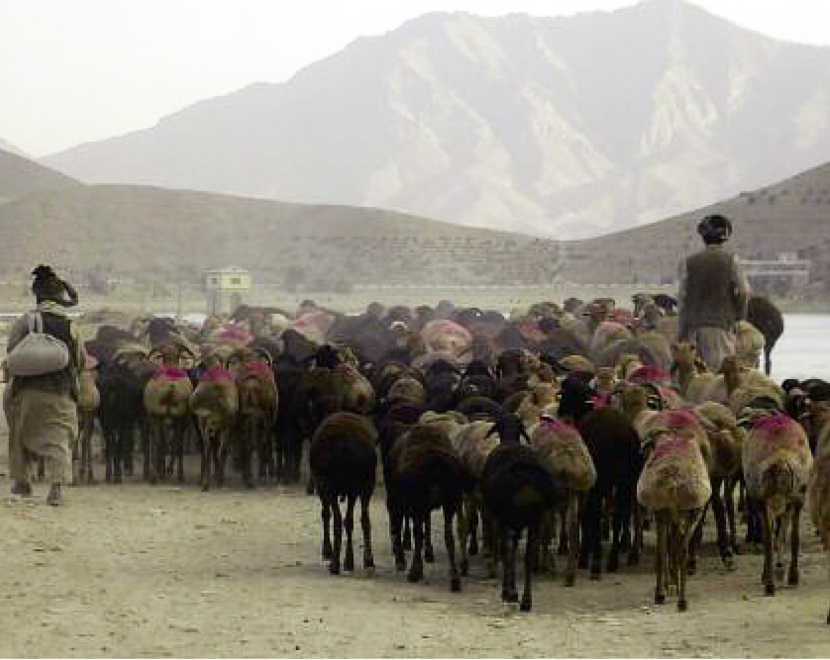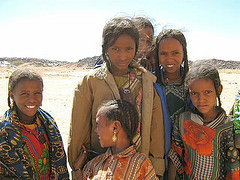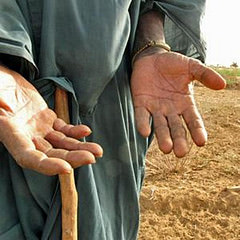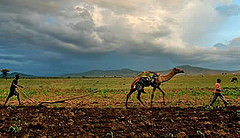
Nomads – a Centuries-old Way of Life is Threatened
— Committee for Development, European Parliament
By Donna Shaver
The earliest peoples of the world were nomads, existing long before the advent of settled communities. They were hunter-gatherers living on the bounty of animals and plants, and moving as necessary to find sufficient food and water. Probably the best-known population of hunter-gathers in modern times is the San (previously called the Bushmen) in what are now Botswana, Namibia, Angola, Zambia, Zimbabwe and South Africa. In the early 1980s, diamonds were discovered in the San reserve. Soon after, government ministers went into the reserve to tell the Bushmen living there that they would have to leave because of the diamond finds. Within the last 50 years, almost all of the San have been settled and effectively banished from returning to their ancestral hunting grounds.
Other hunter-gatherers still exist, but are less well-known, such as the Punan in the Indonesian province of East Kalimantan in the Philipines, the Mbuti in the Ituri Rainforest of Zaire, and the Piraha in the Amazon. According to Survival, the global movement for tribal peoples’ rights, there are over a hundred tribes that are not in contact with the modern world.
Pastoralists
Far more common today are the pastoralists — nomads who are herders, moving their livestock to find good forage and adequate water. Some groups herd only one species, such as the Dukha in Mongolia, who herd reindeer. Others have a more diverse mixture of livestock, such as the Turkana of northern Kenya, which maintains five species: camels, cattle, goats, sheep and donkeys, each with different food and water requirements.
The pastoral life requires mobility, and in many cases, requires crossing borders. The Tuareg, for example, are to be found in several North African countries. Some may live for whole seasons in one location, and may send flocks or herds to higher pastures without having to move the whole community. Other pastoralists have to move herds often to find appropriate grazing. Some cultures move as individual families, some as small groups—each tribe has it’s own traditions. Increasingly, pastoralists may have some settled members. And they are coming under significant pressure, especially in Africa, to give up their way of life.
Challenges to education and healthcare

Climate Change
Climate change is having a profound effect on the lives of pastoralists, particularly in Africa. Droughts have been severe in recent years in northern Africa, and many thousands of pastoralists have been forced to give up herding and settle down. But there is some disagreement on the factors that are at work. Some see nomadic peoples as the first victims of climate change. There is no doubt that pastoralists have lost many animals in drought conditions. Drought has also brought farmers and pastoralists into conflict. Nomadic herders are moving south as a warming climate is destroying grazing land and turning it into desert. In Nigeria’s 11 northernmost states, 35 percent of the land formerly under cultivation has been turned into desert. According to IRIN humanitarian news and analysis in 2009, “The livelihoods of some 15 million pastoralists in northern Nigeria are threatened by decreasing access to water and pasture….” According to the pastoralists, some of the areas in dispute were grazing reserves set aside as international cattle routes.
Pastoralism as a sustainable solution
But others see the pressures on pastoral people from a different perspective. The UN’s International Fund for Agricultural Development has this to say in their paper on Livestock and pastoralists:
“Pastoralists inhabit zones where the potential for crop cultivation is limited due to low and highly variable rainfall conditions, steep terrain or extreme temperatures. Within this unpredictable, vulnerable and dynamic environment, they have developed successful mechanisms of adaptation to maintain an ecological balance between themselves and the natural environment.
Pastoralism is therefore an economic and social system well adapted to dry-land conditions and characterized by a complex set of practices and knowledge that has permitted the maintenance of a sustainable equilibrium among pastures, livestock and people.”
According to the International Institute for Environment and Development’s report, Misconceptions on Dry-lands and Pastoralism, Pastoralism directly supports approximately 20 million people in East Africa, producing 80 percent of the total annual milk supply in Ethiopia, and providing 90 percent of the meat consumed in East Africa. When measured per hectare, pastoralism also out-performs ranching and sedentary livestock keeping in similar environments.
— International Institute for Environment and Development, 2014
Land-grabs: Nomads and Property Rights
But in many African countries, there is a strong movement toward “sedenterism” – forcing pastoral people to settle in one place. There are a number of reasons for this movement, but increasingly it is to free up large tracts of land that can be sold or leased for foreign investment.
In the developing world, most indigenous peoples do not have legal title to the land they may have used for centuries. This is true of most of the land inhabited by villages and small family agricultural plots but even more true for pastoralists, who require access to lands that may be widely dispersed, in more than one country and much of it, at any given time, not in use.
Land sales to corporations
Land formally used by tribes is now being sold off to corporations — often outside of the country — for use in agriculture, bio-fuels and even big game hunting operations. Although it may technically be lucrative for the country, seldom is any of the income used to improve the lives of people who have been displaced by the enterprise. The people whose lands are appropriated are usually pushed aside, with no place to go and no means of support. And many, if not most, of African farmers are women.
“Even so-called ‘empty land’ usually has legitimate tenure rights holders who might use that land for a variety of purposes,” noted Action Aid 2014 in The Great Land Heist. “For example, very little land in Africa is truly idle, given pastoralist activities, traditional land management techniques in semi-arid regions, use of land for ritual/religion, and natural forests providing a source of many essential products.”
For pastoralists, this may mean traditional grazing lands seized, access to water controlled by the new owner, and/or the only routes between grazing areas blocked. Often the affected population doesn’t know about the deal until they are forcibly removed from the land.

When people are dispossessed from the land from which they obtain their livelihood, they add to the ever-growing population of people living in poverty.
The government of Ethiopia forcibly resettled 70,000 semi-nomadic people with plans to resettle more. They arrived in new villages to find little or no food, and no farmland, healthcare, or educational facilities. A troubling aspect of any of the ‘villagization’ programs — the moving of pastoralist populations into more permanent settlements — is the profound negative consequences for women. Vulnerable populations are often forcibly — sometimes at gunpoint — relocated, so that the land might become ‘more productive.’ Often the men leave and the women are left behind to cope with finding food and water, and taking care of children and elders. They are especially vulnerable to assault.
In 2013, the government of Tanzania informed Maasai herders that some 1,500 square kilometers of their land would be cleared as a big-game hunting firm reserve for the royal family of Dubai. Some 40,000 Maasai were to be evicted. After lengthy protests and worldwide petitions, government officials backed down. A global petition was signed by more than 1.7 million people.
Land-grabs and cross-border consequences

Ethiopia’s sugar plantation program points to a significant issue with many of the land deals: it’s not just the land, it’s the water. A report from the Oakland Institute, Understanding Land Investment Deals in Africa, paints a chilling picture of the water implications for both settled and nomadic populations: “If all of the [98 million acres] of land that were acquired on the continent in 2009 come under cultivation, a staggering volume of water would be required for irrigation. The Oakland Institute estimates that 300 to 500 cubic kilometers (km3) of water per year would be used to produce crops on this land, approximately twice the volume of water (184.35 km3) that was used for agriculture in all of Africa in 2005. In the event that the annual rate of land acquisition continues at 2009 levels, demand for fresh water from new land investments alone will overtake the existing supply of renewable fresh water on the continent by 2019.”
The future is not looking bright for pastoralists in Africa, but it is has been shown that they can make effective use of land, and that their way of life is viable if they have access to water and can freely move their herds to find water and grazing. The likelihood is that there will be ever more pressure to settle down and give up their way of life.
— Orumoi Evans, Maasai pastoralist in Kenya
